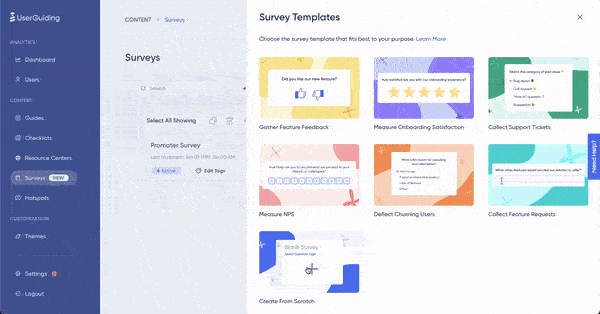

Did you know that U.S. companies could save over $35 billion per year if they focused on keeping their customers happy?
But sometimes things don't work out, and customers walk away. So what happens when they cancel their services and say farewell?
Well, knowing that customers are churning is only half the battle. The real power lies in understanding why they're leaving.
Is it a frustrating customer experience? A lack of communication? Maybe your product just doesn't meet their evolving needs.
Luckily, there's a single solution that achieves all of these goals: Customer cancellation surveys.
In this article, you'll learn
- what customer cancellation surveys are and
- how to create an effective churn survey that will help you develop targeted solutions to not only win back lost customers but also prevent future problems.
Excited already? Let's go!
TL;DR
- Unlike general satisfaction surveys, customer cancellation surveys pinpoint the specific reasons customers leave.
- Mix multiple choice, open-ended, and Likert scale questions to capture both broad trends and detailed feedback.
- Categorize responses and leverage data visualization tools to understand patterns and trends.
- Use the insights to fix problems, win back customers, and prevent future churn.
What is a Cancellation Survey?
Customer cancellation surveys are questionnaires sent to customers specifically when they decide to cancel a subscription or service.
Unlike general customer satisfaction surveys, these surveys target the "why" behind the cancellation.
Their purpose is to gather immediate and specific feedback to understand what's driving customers away and potentially win them back.
Think of cancellation surveys as an emergency room visit for customer relationships. They address the immediate issue and offer a chance to intervene.
General satisfaction surveys, on the other hand, are more like regular checkups that help maintain overall customer health.
Why Use a Customer Cancellation Survey?
- Identify areas for improvement in your product/service: By analyzing cancellation data, you can spot recurring problems and prioritize improvements that benefit all customers.
- Gain insights into customer needs and expectations: Cancellation surveys go beyond "satisfied/dissatisfied" to reveal the specific issues causing customers to leave.
- Develop strategies to win back lost customers (win-back offers): Sometimes, a well-timed survey can identify a small issue you can address. You can offer incentives and special discounts to convince a customer to stay.
- Reduce future churn and improve customer retention: Understanding why customers leave equips you to fix problems and prevent others from following suit.
- Boost customer loyalty: Showing you care about customer feedback encourages customers to give you another chance.
How to Create an Effective Cancellation Survey
In this section, we'll dive into the essential steps of creating and distributing customer cancellation surveys. These steps will improve your survey completion rates.
1- Delivery Methods
There are several ways to get valuable feedback from departing customers. Check out these options to send cancellation surveys.
In-App Pop-up
Present the survey directly within your app or website during the cancellation process. This makes it easy for customers to respond while the experience is fresh in their minds.
Post-Cancellation Email
Send a follow-up email shortly after cancellation with a link to the survey. This allows for a calmer response and may capture feedback from customers who weren't comfortable answering in the heat of the moment.
SMS Text Message
For specific demographics, a quick text message survey can be an efficient way to gather feedback, especially if the survey is concise.
Phone Call
For high-value customers or complex cancellations, a personalized phone call can provide deeper insights and potentially salvage the relationship.
2- Cancellation Survey Question Structure
Multiple choice for common reasons
Present a list of common cancellation reasons with the option to select all that apply. This is efficient for capturing broad trends and specific pain points.
- Example: "Why are you canceling today?" with options like "Price is too high," "Not meeting my needs," etc.
Open-ended for detailed feedback
Allow customers to elaborate on their reasons for leaving in their own words. This provides rich, detailed feedback that can reveal unexpected issues.
- Example: "What can we do to improve your experience?"
Likert scale for satisfaction levels
Use a scale (e.g., Strongly Disagree - Strongly Agree) to gauge customer sentiment on specific aspects of your service.
- Example: "How satisfied were you with the customer support experience?"
Rank order for customer needs
Present several features or functionalities and ask customers to rank them in order of importance. This helps identify areas for improvement based on customer needs.
- Example: Please rank the following features in order of importance to you (1 = Most Important, 5 = Least Important):
- Ease of use
- Feature A
- Feature B
- Customer support availability
- Price
💡 Quick Tip: Did you know that UserGuiding helps you create custom in-app cancellation surveys in minutes?
Type your question, choose your survey type (multiple choice, Likert scale, etc.), lean back, and watch how UserGuiding captures real-time customer feedback to fight churn!

3- Sample Cancellation Survey Questions
Here are some churn survey questions to ask to understand your churn users and to improve your product accordingly.
You can significantly reduce churn using valuable insight by collecting feedback with a well-designed cancellation survey.
1- Multiple choice (Frequency)
How often did you encounter issues that prevented you from using our product/service effectively? (Never, Rarely, Occasionally, Frequently, Always)
2- Open-Ended (Specific Feature)
What improvements would you like to see in regards to [specific feature customers might be unhappy with]?
3- Checkbox (Feature Usage)
Which of the following features did you use most often? (Select all that apply)
This can help identify underutilized features that might be confusing customers.
4- Multiple Choice (Alternatives)
If you're switching to another service, which provider are you going with and why?
(Optional: Open-ended - Why did you choose them over us?)
5- Likert Scale (Multiple Aspects)
Please rate your satisfaction with the following aspects of our service (Strongly Dissatisfied - Strongly Satisfied):
- Product Functionality
- Customer Support Responsiveness
- Value for Money
6- Open-Ended (Future Use)
Is there a chance you might consider using our product/service again in the future? If so, what would need to change for that to happen?
7- Multiple Choice (Cancellation Reason - Specific)
Regarding price, was our pricing:
- Too high overall
- Not competitive with similar services
- Lacking transparent pricing options
8- Multiple Choice (Cancellation Stage)
At what point in your experience with us did you decide to cancel? (During signup process, After the initial trial period, After using the service for a while)
9- Open-Ended (Proactive Improvement)
Is there anything else you'd like to share that could help us improve our service for future customers?
10- NPS Score
On a scale of 0-10, how likely are you to recommend our product/service to a friend or colleague?
Analyzing Cancellation Survey Data
Once you've gained valuable feedback through your cancellation surveys, it's time to transform it into actionable insights. Here's how to categorize and analyze your data:
Categorization
Group Responses by Theme
Start by reading through open-ended responses and categorizing them based on common themes.
For example, comments about pricing can be grouped under a "Cost" category, while usability issues might fall under a "Product Functionality" category.
Utilize Multiple Choice Data
Analyze the selections made in your multiple-choice questions. Identify the most frequently chosen reasons for cancellation and create categories based on these trends.
Analysis
Quantitative Analysis
Use software or spreadsheets to analyze quantitative data like Likert scale responses and NPS scores. Calculate averages and identify areas where customer satisfaction falls short.
Analyze trends in cancellation rates over time. Are there seasonal fluctuations or spikes related to specific events or product changes?
Qualitative Analysis
Analyze open-ended responses to understand the sentiment behind cancellations. Look for recurring phrases or specific issues customers mention frequently.
Look for connections between quantitative and qualitative data. For example, low NPS scores might correlate with specific pain points mentioned in open-ended responses.
Segmentation
Segment your data by customer demographics, subscription plans, or usage patterns. This can reveal specific customer groups most prone to churn and help tailor your efforts accordingly.
Tools and Techniques
Data Visualization Tools
Leverage data visualization tools to create charts, graphs, and word clouds that represent your data.
For instance, a bar chart might reveal which cancellation reasons are most prevalent, while a word cloud can highlight the most frequently used words in open-ended responses, providing quick insights into customer sentiment.
Sentiment Analysis Tools
Utilize software that analyzes the emotional tone of open-ended responses, providing insights into customer frustration or satisfaction.
Customer Journey Mapping
Combine cancellation data with customer interaction data to map out the customer journey and identify potential drop-off points.
Conclusion
Don't let customers walk out the door quietly. Cancellation surveys can turn their goodbyes into valuable feedback to strengthen your business and keep it thriving.
Remember, a satisfied customer is a loyal customer, and by actively listening to the departing voices through perfect cancellation surveys, you can ensure your business thrives in the ever-competitive marketplace.
Frequently Asked Questions
What are 5 good survey questions?
- What improvements would you like to see in regards to [specific feature customers might be unhappy with]?
- Which of the following features did you use most often?
- If you're switching to another service, which provider are you going with and why?
- Please rate your satisfaction with the following aspects of our service.
- Is there a chance you might consider using our product/service again in the future? If so, what would need to change for that to happen?

















.svg)
.svg)
.svg)
.svg)
.svg)

.svg)
.svg)












.svg)
.svg)




.png)
















